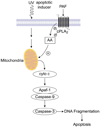Role of platelet-activating factor in cell death signaling in the cornea: A review
- PMID: 20431963
- PMCID: PMC2929926
- DOI: 10.1007/s12035-010-8129-1
Role of platelet-activating factor in cell death signaling in the cornea: A review
Abstract
Platelet-activating factor (PAF) is a potent bioactive lipid generated in the cornea after injury whose actions are mediated through specific receptors. Studies from our laboratory have shown that PAF interactions with its receptors activate several transmembrane signals involved in apoptosis. Continuous exposure to PAF during prolonged inflammation increases keratocyte apoptosis and inhibition of epithelial adhesion to the basement membrane. As a consequence, there is a marked delay in wound healing, which is not countered by the action of growth factors. While apoptosis of stroma cells is rapid and potent, epithelial cells as well as myofibroblasts, which appear in the stroma during the repair phase, are resistant to apoptosis. However, PAF accelerates apoptosis of corneal epithelial cells exposed to oxidative stress by stimulating phospholipase A2, producing an early release of cytochrome C from mitochondria and activating caspase-3. In myofibroblasts, PAF has a synergistic action with tumor necrosis factor-alpha (TNF-alpha), increasing apoptosis of the cells to 85%. PAF antagonists block the effects of PAF and could have a therapeutic role in maintaining a healthy and transparent cornea.
Figures





Similar articles
-
The role of platelet-activating factor in the corneal response to injury.Prog Retin Eye Res. 2002 Sep;21(5):449-64. doi: 10.1016/s1350-9462(02)00011-3. Prog Retin Eye Res. 2002. PMID: 12207945 Review.
-
Synergistic effect of platelet-activating factor and tumor necrosis factor-alpha on corneal myofibroblast apoptosis.Invest Ophthalmol Vis Sci. 2006 Mar;47(3):883-91. doi: 10.1167/iovs.05-0581. Invest Ophthalmol Vis Sci. 2006. PMID: 16505020
-
Delay of corneal epithelial wound healing and induction of keratocyte apoptosis by platelet-activating factor.Invest Ophthalmol Vis Sci. 2002 May;43(5):1422-8. Invest Ophthalmol Vis Sci. 2002. PMID: 11980856
-
Lipoxin A₄ inhibits platelet-activating factor inflammatory response and stimulates corneal wound healing of injuries that compromise the stroma.Exp Eye Res. 2012 Oct;103:9-16. doi: 10.1016/j.exer.2012.07.008. Epub 2012 Jul 22. Exp Eye Res. 2012. PMID: 22828048 Free PMC article.
-
The corneal fibrosis response to epithelial-stromal injury.Exp Eye Res. 2016 Jan;142:110-8. doi: 10.1016/j.exer.2014.09.012. Exp Eye Res. 2016. PMID: 26675407 Free PMC article. Review.
Cited by
-
Therapeutic implications of disorders of cell death signalling: membranes, micro-environment, and eicosanoid and docosanoid metabolism.Br J Pharmacol. 2012 Jun;166(4):1193-210. doi: 10.1111/j.1476-5381.2012.01900.x. Br J Pharmacol. 2012. PMID: 22364602 Free PMC article. Review.
-
Platelet-activating factor (PAF) antagonistic activity of a new biflavonoid from Garcinia nervosa var. pubescens King.Molecules. 2012 Sep 10;17(9):10893-901. doi: 10.3390/molecules170910893. Molecules. 2012. PMID: 22964504 Free PMC article.
-
Inhibitory effects of acetylmelodorinol, chrysin and polycarpol from Mitrella kentii on prostaglandin E₂ and Thromboxane B₂ production and platelet activating factor receptor binding.Molecules. 2012 Apr 26;17(5):4824-35. doi: 10.3390/molecules17054824. Molecules. 2012. PMID: 22538486 Free PMC article.
-
Annonaceae: Breaking the Wall of Inflammation.Front Pharmacol. 2017 Oct 20;8:752. doi: 10.3389/fphar.2017.00752. eCollection 2017. Front Pharmacol. 2017. PMID: 29104539 Free PMC article. Review.
-
Three-dimensional cell culture environment promotes partial recovery of the native corneal keratocyte phenotype from a subcultured population.Tissue Eng Part A. 2013 Jul;19(13-14):1564-72. doi: 10.1089/ten.TEA.2012.0084. Epub 2013 Apr 16. Tissue Eng Part A. 2013. PMID: 23410050 Free PMC article.
References
-
- Birk DE, Fitch JM, Linsenmayer TF. Organization of collagen type I and V in the embryonic chicken cornea. Invest Ophthalmol Vis Sci. 1986;27:1470–1477. - PubMed
-
- Green M, Apel A, Stepleton F. A longitudinal study of trends in keratitis in Australia. Cornea. 2008;27:33–39. - PubMed
-
- Pfister RR, Burnstein N. The alkali burned cornea: I: epithelial and stromal repair. Exp Eye Res. 1976;23:519–535. - PubMed
Publication types
MeSH terms
Substances
Grants and funding
LinkOut - more resources
Full Text Sources
Research Materials

